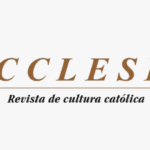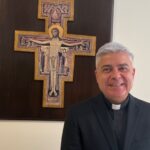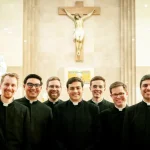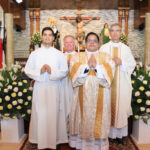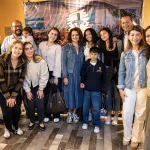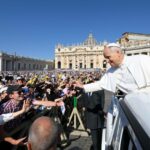“In her and with her, God becomes brother and companion on the journey, carrying our crosses with us so we are not crushed by our pains,” said Pope Francis in his homily during the Mass celebrated at the Sanctuary of Our Lady of Guadalupe.
At the end of the first day of his Apostolic Visit to Mexico, the Holy Father celebrated the Eucharist alongside thousands of faithful gathered at the largest Marian sanctuary in this country and in the world. In his homily, the Pontiff reminded us that “the Virgin Mary is and will always be recognized as the woman of ‘yes,’ a yes of surrender to God and, at the same time, a yes of surrender to her brothers and sisters. It is that yes that set her in motion to give her best, going on the way to meet others.”
“Just as she was present to little Juanito, in the same way she continues to be present to all of us,” said the Pope, “especially to those who, like him, feel that they are worth nothing. This particular, let’s say preferential, choice was not against anyone but in favor of everyone.”
Therefore, the Bishop of Rome affirmed, “God awakened and awakens the hope of the little ones, the suffering, the displaced and discarded, all those who feel they do not have a worthy place in these lands.” It is necessary to build the Sanctuary of God, and this Sanctuary, the Pope pointed out, is the life of his children, of all and in all their conditions, especially of young people without a future exposed to countless painful, risky situations, and of the elderly without recognition, forgotten in many corners.
That is why a little silence can do us good, said the Pope, and “look at her, look at her a lot and calmly. And in this looking at her, listen once again as she tells us: ‘What is it, my little son? What saddens your heart? Am I not here, I who have the honor of being your mother?’”
Full text and audio of Pope Francis’s homily
We hear how Mary went to meet her cousin Elizabeth. Without delay, without doubts, without slowness, she accompanies her relative who was in the last months of pregnancy.
The encounter with the angel did not stop Mary because she did not feel privileged, nor did she think she had to withdraw from the life of her loved ones. On the contrary, it rekindled and set in motion an attitude by which Mary is and will always be recognized as the woman of “yes,” a yes of surrender to God and, at the same time, a yes of surrender to her brothers and sisters. It is that yes that set her in motion to give her best, going on the way to meet others.
Listening to this Gospel passage and in this house has a special flavor. Mary, the woman of yes, also wanted to visit the inhabitants of these lands of America in the person of the Indian Saint Juan Diego. And just as she moved along the roads of Judea and Galilee, she also walked to Tepeyac, with her clothes, using her language, to serve this great Nation. And just as she accompanied Elizabeth’s pregnancy, she has accompanied and continues to accompany the gestation of this blessed Mexican land. Just as she was present to little Juanito, in the same way she continues to be present to all of us; especially to those who, like him, feel “they were worth nothing” (cf. Nican Mopohua, 55). This particular, let’s say preferential, choice was not against anyone but in favor of everyone. Little Indian Juan, who called himself “mecapal, cacaxtle, tail, wing,” that is, “subjected to another’s charge” (cf. ibid, 55), became “the ambassador, very trustworthy.”
On that dawn of December 1531, the first miracle took place, which will later be the living memory of everything this Sanctuary guards. On that dawn, in that encounter, God awakened the hope of his son Juan, the hope of a People. On that dawn, God awakened and awakens the hope of the little ones, the suffering, the displaced and discarded, all those who feel they do not have a worthy place in these lands. On that dawn, God approached and approaches the suffering but resilient heart of so many mothers, fathers, grandparents who have seen their children leave, lose, or even be stolen from them criminally.
On that dawn, Juancito experiences in his own life what hope is, what God’s mercy is. He is chosen to supervise, care for, guard, and promote the construction of this Sanctuary. Repeatedly, he told the Virgin that he was not the right person; on the contrary, if he wanted to carry out that work, he had to choose others because he was not educated, literate, or part of the group that could do it. Mary, stubborn — with the stubbornness born from the merciful heart of the Father — told him: no, he would be her ambassador.
This awakens something he could not express, a true banner of love and justice: in building that other sanctuary, the one of life, of our communities, societies, and cultures, no one can be left out. We are all necessary, especially those who usually do not count because they are not “up to the circumstances” or because they do not “contribute the necessary capital” for their construction. The Sanctuary of God is the life of his children, of all and in all their conditions, especially of young people without a future exposed to countless painful, risky situations, and of the elderly without recognition, forgotten in many corners. The sanctuary of God is our families that need the minimum necessary to be able to build and rise. The sanctuary of God is the face of so many who go out onto our paths…
Coming to this Sanctuary, we might experience the same as Juan Diego. Looking at the Mother from our pains, fears, desperations, sadness, and saying to her: “Mother, what can I contribute if I am not literate?” We look at the Mother with eyes that say: so many situations take away our strength, make us feel there is no space for hope, for change, for transformation.
That is why I believe that today a little silence will do us good, and looking at her, looking at her a lot and calmly, and telling her as that other son who loved her very much did:
“Simply looking at you, Mother,
leaving only the gaze open;
looking at you entirely without saying anything,
telling you everything, mute and reverent.
Do not disturb the wind of your forehead;
only cradle my violated solitude,
in your eyes of a loving Mother
and in your nest of transparent earth.
The hours collapse; shaken,
fools bite the trash
of life and death, with their noises.
Looking at you, Mother; contemplating you barely,
the heart silent in your tenderness,
in your chaste silence of lilies.”
(Liturgical hymn)
And in silence, and in this looking at her, listen once again as she tells us: “What is it, my little son? What saddens your heart?” (cf. Nican Mopohua, 107.118). “Am I not here, I who have the honor of being your mother?” (ibid., 119).
She tells us she has the “honor” of being our mother. That gives us the certainty that the tears of those who suffer are not sterile. They are a silent prayer that rises to heaven and that finds always a place in her mantle. In her and with her, God becomes brother and companion on the journey, carrying our crosses with us so we are not crushed by our pains.
Am I not your mother? Am I not here? Do not let your pains and sadness defeat you, she tells us. Today she again sends us like Juancito; today she again tells us, be my ambassador, be my envoy to build so many and new sanctuaries, accompany so many lives, console so many tears. Just walk along the paths of your neighborhood, your community, your parish as my ambassador, my ambassador; build sanctuaries sharing the joy of knowing that we are not alone, that she goes with us. Be my ambassador, she tells us, giving food to the hungry, drink to the thirsty, making room for the needy, clothing the naked, and visiting the sick. Help those who are imprisoned, do not leave them alone, forgive those who hurt you, console those who are sad, be patient with others and, especially, ask and beg our God, and in silence, tell him what is in your heart.
Am I not your mother? Am I not here? Again, Mary tells us. Go build my sanctuary, help me raise the life of my children, who are your brothers.
Source: news.va




